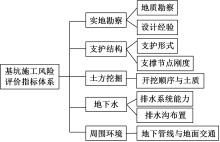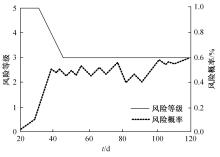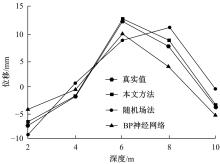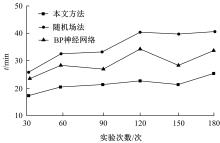Journal of Jilin University(Engineering and Technology Edition) ›› 2022, Vol. 52 ›› Issue (12): 2892-2897.doi: 10.13229/j.cnki.jdxbgxb20211278
Previous Articles Next Articles
Risk identification method of foundation pit engineering of high⁃rise buildings based on fuzzy clustering maximum tree algorithm
Han-chao LIAO( ),Mi-yuan SHAN(
),Mi-yuan SHAN( )
)
- School of Business,Hunan University,Changsha 410082,China
CLC Number:
- TU94
| 1 | 钟春玲,梁东,张云龙,等. 体外预应力钢-混凝土组合简支梁自振频率计算[J].吉林大学学报:工学版,2020,50(6):2159-2166. |
| Zhong Chun-ling, Liang Dong, Zhang Yun-long, et al. Calculation of natural frequency of externally prestressed steel-concrete composite simply supported beams[J]. Journal of Jilin University(Engineering and Technology Edition), 2020,50(6):2159-2166. | |
| 2 | 钱雪忠,姚琳燕. 面向稀疏高维大数据的扩展增量模糊聚类算法[J]. 计算机工程,2019,45(6):75-81, 88. |
| Qian Xue-zhong, Yao Lin-yan. Extended incremental fuzzy clustering algorithm for sparse high-dimensional big data[J]. Computer Engineering, 2019,45(6):75-81, 88. | |
| 3 | Ren X, Fan W, Li J, et al. Building information model-based finite element analysis of high-rise building community subjected to extreme earthquakes[J]. Advances in Structural Engineering, 2019, 22(4):971-981. |
| 4 | 王飞球,黄健陵,符竞,等. 基于BP神经网络的跨既有线高速铁路桥梁施工安全风险评估[J].铁道科学与工程学报,2019,16(5):1129-1136. |
| Wang Fei-qiu, Huang Jian-ling, Fu Jing, et al. Risk assessment of construction safety of high-speed railway bridge across existing lines based on BP neural network[J]. Journal of Railway Science and Engineering, 2019,16(5):1129-1136. | |
| 5 | 华莹,何军,赵金城. 高层建筑施工现场危险区域识别及评估方法研究[J].施工技术,2019,48(6):100-104. |
| Hua Ying, He Jun, Zhao Jin-cheng. Research on identification and evaluation method of hazardous area of high-rise building construction site[J]. Construction Technology, 2019, 48(6):100-104. | |
| 6 | Nakaguro M, Sato Y, Tada Y, et al. Prognostic implication of histopathologic indicators in salivary duct carcinoma: proposal of a novel histologic risk stratification model[J]. American Journal of Surgical Pathology, 2019, 44(4):526-535. |
| 7 | 荀志远,张丽敏,徐瑛莲,等. 基于组合赋权云模型的装配式建筑安全风险评价[J]. 数学的实践与认识,2020,50(7):302-310. |
| Xun Zhi-yuan, Zhang Li-min, Xu Ying-lian, et al. Evaluation of prefabricated buildings safety risk based on combination weighting and cloud model[J]. Mathematics in Practice and Theory, 2020,50(7):302-310. | |
| 8 | Wang W Y, Wang Y. Diagnosis index system setup for implementation status management in large-scale construction projects[J]. Mathematical Problems in Engineering, 2021(1): 1-9. |
| 9 | 郭文娟. 大数据背景下的房屋建筑施工风险评估模型[J]. 科技通报,2019,35(4):198-201. |
| Guo Wen-juan. Risk assessment model for building construction under the background of big data[J]. Bulletin of Science and Technology, 2019,35(4):198-201. | |
| 10 | Chen W, Zhang G, Jiao Y, et al. Unascertained measure-set pair analysis model of collapse risk evaluation in mountain tunnels and its engineering application[J]. KSCE Journal of Civil Engineering, 2020, 25(6):1-17. |
| 11 | 李蒙,邹健,刘苹,等. 基于BIM的隧道施工安全风险辨识模型研究[J].工业安全与环保,2019,45(5):69-71. |
| Li Meng, Zou Jian, Liu Ping, et al. Research on tunnel construction safety risk identification model based on BIM[J]. Industrial Safety and Environmental Protection, 2019,45(5):69-71. | |
| 12 | Lu Y, Gong P, Tang Y, et al. BIM-integrated construction safety risk assessment at the design stage of building projects[J]. Automation in Construction, 2021, 124(2): No.103553. |
| 13 | 黄俊斌,张国维,闫肃,等. 基于物联网技术的建筑火灾风险动态评估[J]. 消防科学与技术,2020,39(10):1371-1375. |
| Huang Jun-bin, Zhang Guo-wei, Yan Su, et al. Dynamic assessment of building fire risk based on internet of things technology[J]. Fire Science and Technology, 2020,39(10):1371-1375. | |
| 14 | Baat M, Wieringa N, Droge S, et al. Smarter sediment screening: effect-based quality assessment, chemical profiling, and risk identification[J]. Environmental Science and Technology, 2019, 53(24):14479-14488. |
| 15 | 吴贤国,冯宗宝,秦文威,等. 基于物元理论和证据理论的盾构隧道施工邻近建筑物风险评价[J].铁道标准设计,2020,64(4):104-110. |
| Wu Xian-guo, Feng Zong-bao, Qin Wen-wei, et al. Risk assessment of adjacent buildings induced by shield tunneling construction based on matter-element theory and extension theory[J]. Railway Standard Design, 2020,64(4):104-110. | |
| 16 | Man S S, Chan A, Alabdulkarim S. Quantification of risk perception: development and validation of the construction worker risk perception(CoWoRP) scale[J]. Journal of Safety Research, 2019, 71:25-39. |
| 17 | Yang J, Wang J, Wei G, et al. An adaptive probabilistic mapping matrix search algorithm for vulnerability analysis of PPS[J]. Annals of Nuclear Energy, 2019, 131:433-442. |
| 18 | 李依霖. 复杂网络隐私信息传输入侵风险评估仿真[J].计算机仿真,2020,37(6):156-159, 164. |
| Li Yi-lin. Intrusion risk assessment simulation of big data privacy information transmission in complex network[J]. Computer Simulation, 2020,37(6):156-159, 164. | |
| 19 | Kayhan B M, Cebi S, Kahraman C. Determining and prioritizing main factors of supplier reliability in construction industry[J]. Journal of Multiple-valued Logic and Soft Computing, 2019, 32(1/2):111-134. |
| 20 | Stewart M G, Li J. Risk-based assessment of blast-resistant design of ultra-high performance concrete columns[J]. Structural Safety, 2021, 88(3):No.102030. |
| [1] | SI Jian-bo, YAO Yan, GUO Wei-ying, YANG Fang. Web user cluster method and realization based on fuzzy clustering [J]. 吉林大学学报(工学版), 2013, 43(增刊1): 485-488. |
| [2] | LU Shan, LEI Ying-jie, KONG Wei-wei, LEI Yang, ZHENG Kou-quan. Robust fundamental matrix estimation based on kernel fuzzy clustering [J]. 吉林大学学报(工学版), 2012, 42(02): 434-439. |
| [3] | SHEN Xuan-jing, WANG Kai-ye, QIAN Qing-ji, LIU Ying-jie, LI Xiang. Image segmentation using adaptive balloon force snake model [J]. 吉林大学学报(工学版), 2011, 41(05): 1394-1400. |
| [4] |
Xu Xin-wei,Zhou Liang,Xu Xiao-ming, Ding Qiu-lin .
User intention recognition for Web initiative services based on hybrid intelligent mining [J]. 吉林大学学报(工学版), 2007, 37(02): 419-0423. |
| [5] | Lu Ying-rong,Yang Yin-sheng,Lv Feng . Optimal vehicle routing problem based on fuzzy clustering analysis [J]. 吉林大学学报(工学版), 2006, 36(增刊2): 147-151. |
|







